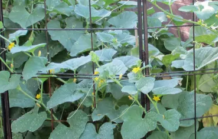A report released today by the Natural Resources Defense Council (NRDC) finds cover crops can suck tons of carbon pollution from the air, significantly cut crop losses and prevent the loss of a trillion gallons of water. In fact, planting cover crops on half the corn and soybean acres in the top 10 agricultural states (California, Iowa, Texas, Nebraska, Minnesota, Illinois, Kansas, Wisconsin, North Carolina, and Indiana) could sequester more than 19 million metric tons of carbon annually – the equivalent of taking more than 4 million cars off the road.
“Extreme weather conditions such as drought and flooding are already having major impacts on farms, and they are only expected to become more common and more severe in coming years,” said Ben Chou, report co-author and NRDC water policy analyst specializing in climate science. “It’s going to take a global effort to slow down the rate at which our world is warming and we’ll have to use every tool in our arsenal; cover crops are one of those tools.”
Over the past five years, farmers in the top 10 agricultural states lost more than $25 billion worth of crops due to drought, heat, hot wind, extreme rainfall, flooding and other climate-related impacts. Scientists anticipate that climate change will result in higher numbers of consecutive dry days and hot nights, negatively affecting crop yields, especially in the western and southern parts of the country. Higher temperatures in conjunction with longer dry periods will increase crop water requirements, likely exacerbating water shortages. When it does rain, precipitation is expected to occur in heavier, more intense rainfall events, increasing the risk of soil erosion.
NRDC’s report, Climate-Ready Soil: How Cover Crops Can Make Farms More Resilient to Extreme Weather Risks, examines the carbon capture and water-holding benefits of soil stewardship methods to improve soil health in the 10 highest-value-producing agricultural states in the United States and includes data on annual average crop losses, as well as projected climate change impacts across the country, the effects on crops, and the benefits of cover crops.
Climate-Ready Soil’s analysis reveals that using cover crops and other soil stewardship practices to increase organic matter in soil by 1 percent on half of the corn and soybean acres in the top 10 agriculture states could help the soil hold an additional trillion gallons of water, which is enough water to meet the annual needs of nearly 33 million people.
“Whether it’s the ongoing California drought or the drenching spring rains in Texas, farmers are constantly struggling to manage the water on their farms,” said report co-author and Soil Health Fellow Lara Bryant. “Unfortunately, dealing with the effects of climate change is becoming the new normal, and farmers have an opportunity to be part of the solution – and that includes doing more with less water. Thankfully, investing in healthy soil is a win-win for everyone.”
State-specific benefits highlighted in the report for farmers included:
- California: 540,000 metric tons of carbon pollution captured annually; and 10.9 billion gallons of water stored. (Click here for California fact sheet.)
- Illinois: 4 million metric tons of carbon pollution captured annually; and 214 billion gallons of water stored. (Click here for Illinois fact sheet.)
- Indiana: 2.1 million metric tons of carbon pollution captured annually; and 113 billion gallons of water stored. (Click here for Indiana fact sheet.)
- Iowa: 4.3 million metric tons of carbon pollution captured annually; and 234 billion gallons of water stored. (Click here for Iowa fact sheet.)
- Kansas: 1.4 million metric tons of carbon pollution captured annually; and 81 billion gallons of water stored. (Click here for Kansas fact sheet.)
- Minnesota: 2.9 million metric tons of carbon pollution captured annually; and 157 billion gallons of water stored. (Click here for Minnesota fact sheet.)
- Nebraska: 2.5 million metric tons of carbon pollution captured annually; and 145 billion gallons of water stored. (Click here for Nebraska fact sheet.)
- North Carolina: 442,000 metric tons of carbon pollution captured annually; and 24 billion gallons of water stored. (Click here for North Carolina fact sheet.)
- Texas: 297,000 metric tons of carbon pollution captured annually; and 19 billion gallons of water stored. (Click here for Texas fact sheet.)
- Wisconsin: 1.1 million metric tons of carbon pollution captured annually; and 60 billion gallons of water stored. (Click here for Wisconsin fact sheet.)
Background
Cover crops are crops grown with the specific purpose of building soil health and increasing biodiversity on farms focused on growing major commodity crops. Farmers who used cover crops over the last three growing seasons have consistently averaged higher yields than farmers who did not, according to recent USDA surveys. The yield benefit from cover crops was most pronounced in the areas hardest hit by the historic Midwest drought in 2012, demonstrating the importance of cover crops in drought-proofing fields.
Other soil health best practices include no-till farming – a planting method that involves drilling seeds directly into the stubble from the previous year’s crops, rather than plowing up this residue, resulting in more soil moisture, weed suppression and increased yields; compost application – using nutrient rich compost to improve soil productivity; and diversified farming – planting several different types of crops and rotating them from year-to-year to improve biodiversity and soil biology.
As harvest season ends and farmers in the United States ready themselves for winter, one small change could make a huge difference in their soil’s health and the health of our climate-impacted world: planting cover crops.




